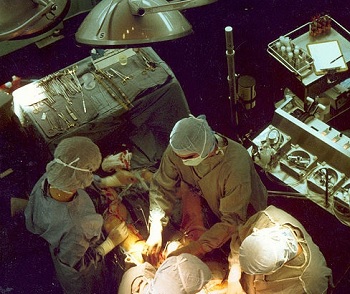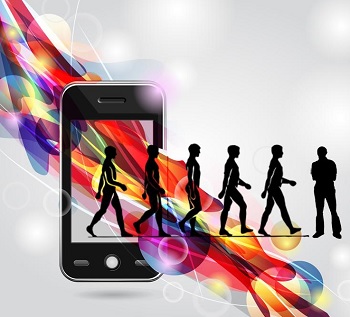This was the first time that the augmented reality headset had been used for this purpose.
For the very first time ever, a surgeon in China used a Google Glass headset device to broadcast the full procedure of an orthopedic surgery so that it could be viewed, live, by his colleagues in other parts of Asia, as well as in Europe, on their tablets and smartphones.
The surgery was conducted by a highly known and reputable orthopedic surgeon at a hospital in China.
The surgery was conducted by an expert in the reattachment of limbs that have been severed. The doctor wore the Google Glass augmented reality device in order to be able to live-cast the complete procedure using the 500 megapixel camera of the wearable technology gadget. While this event may have been only the first of its kind, recent reports have been suggesting that this could be situation that becomes increasingly common in the future.
The hospital is currently in talks to help to expand the use of Google Glass and other forms of mobile technology.
 Technology news reports – such as those in the Wenwei newspaper, which is state operated – have stated the Shanghai 6th People’s Hospital is currently in discussions with app developers in order to be able to broaden the exploration of the possibility of interactions between humans and machines, on site in the hospital. Among the possibilities that could be among those being discussed is the ability to conduct surgical procedures through the help of 3D images that are displayed in augmented reality while wearing AR glasses.
Technology news reports – such as those in the Wenwei newspaper, which is state operated – have stated the Shanghai 6th People’s Hospital is currently in discussions with app developers in order to be able to broaden the exploration of the possibility of interactions between humans and machines, on site in the hospital. Among the possibilities that could be among those being discussed is the ability to conduct surgical procedures through the help of 3D images that are displayed in augmented reality while wearing AR glasses.
The surgeon’s name is Chen Yunfeng. While he is not the first to use augmented reality glasses in the operating room, he is the first one to use them in order to transmit a live broadcast to doctors in other locations such as other continents.
The medical industry is among those that is seeing the most potential for Google Glass. There are an increasing number of reports being released as various doctors and hospitals come up with new and clever ways to use the technology in order to improve the healthcare that they are able to provide.
As runways were stomped by models in cutting edge menswear fashions, wearables were also in the spotlight.
As the first ever Men’s Fashion Week was hosted in Toronto, all eyes were focused not only on the very latest and hottest in menswear, but were also on high tech wearable technology in a range of different forms.
Everything from LED helmets to brain-sensing headbands – and everything in between – was present.
Even a wearable technology tie made its way down the runway in the Canadian city’s fashion shows for men that took place at the Fairmont Royal York hotel. The wearables were spotted in a number of shapes and designs and were used for several different purposes. The primary show for this tech was presented by We Are Wearables, which is an organization that is based within the city. Its goal was to make this type of device more accessible to both consumers and businesses alike.
The purpose of the inclusion of wearable technology in the fashion show was to promote innovation and adoption.
 This emerging mobile technology is already starting to change the way that people think about fashion and tech. Now, We Are Wearables is hoping to facilitate the incorporation of one into the other. The participation in Toronto Men’s Fashion Week was only the latest in a number of broad scale efforts being made by the company to bring these mobile devices into everyday life. It has also already been holding the largest recurring werables meetup in Canada. That now occurs on a monthly basis and boasts a community made up of over 1,300 members.
This emerging mobile technology is already starting to change the way that people think about fashion and tech. Now, We Are Wearables is hoping to facilitate the incorporation of one into the other. The participation in Toronto Men’s Fashion Week was only the latest in a number of broad scale efforts being made by the company to bring these mobile devices into everyday life. It has also already been holding the largest recurring werables meetup in Canada. That now occurs on a monthly basis and boasts a community made up of over 1,300 members.
On the runway, the organization was hoping to be able to showcase the breadth of the spectrum of wearable devices, ranging from gadgets to allow the wearer to better understand him or herself, to providing improved visibility as a combination feature between style and safety.
Among the featured wearable technology devices that were seen include the Muse brain sensing headband from IntraXon to MeU LED panel infused clothing. The organization wanted to show that this type of tech is equally a matter of design and function and that fashion remains a vital element to the success of these gadgets.
 Technology news reports – such as those in the Wenwei newspaper, which is state operated – have stated the Shanghai 6th People’s Hospital is currently in discussions with app developers in order to be able to broaden the exploration of the possibility of interactions between humans and machines, on site in the hospital. Among the possibilities that could be among those being discussed is the ability to conduct surgical procedures through the help of 3D images that are displayed in augmented reality while wearing AR glasses.
Technology news reports – such as those in the Wenwei newspaper, which is state operated – have stated the Shanghai 6th People’s Hospital is currently in discussions with app developers in order to be able to broaden the exploration of the possibility of interactions between humans and machines, on site in the hospital. Among the possibilities that could be among those being discussed is the ability to conduct surgical procedures through the help of 3D images that are displayed in augmented reality while wearing AR glasses.
 This emerging mobile technology is already starting to change the way that people think about fashion and tech. Now, We Are Wearables is hoping to facilitate the incorporation of one into the other. The participation in Toronto Men’s Fashion Week was only the latest in a number of broad scale efforts being made by the company to bring these mobile devices into everyday life. It has also already been holding the largest recurring werables meetup in Canada. That now occurs on a monthly basis and boasts a community made up of over 1,300 members.
This emerging mobile technology is already starting to change the way that people think about fashion and tech. Now, We Are Wearables is hoping to facilitate the incorporation of one into the other. The participation in Toronto Men’s Fashion Week was only the latest in a number of broad scale efforts being made by the company to bring these mobile devices into everyday life. It has also already been holding the largest recurring werables meetup in Canada. That now occurs on a monthly basis and boasts a community made up of over 1,300 members.